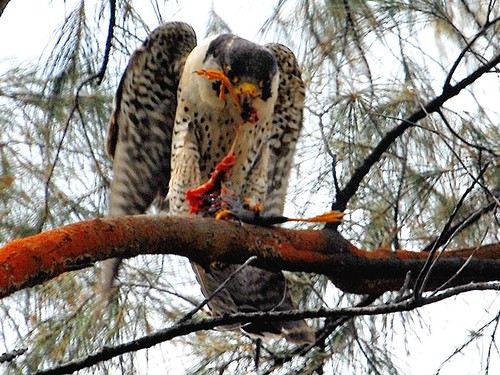
STOMPer Draven doesn't know what to do with these several pigeons who have made a home at his neighbour's aircon lodge. Sometimes, they even try to camp at his place.
Says this STOMPer:
"I have several pigeons staying at my neighbour's aircon lodge. I am not sure who could I approach for this issue.
"These birds even try to camp at my place but I always chased them away.
"How I wish the town council would deploy the cleaning guys to wash the exterior walls so that they could also clean them. But no luck so far."

Not many people like feral pigeons (Columbia livia). It really is very strange how a single species can be so revered and so reviled at the same time. On one hand, you have people who raise and breed fancy pigeons, and enter competitions. Charles Darwin's work with breeding pigeons helped in the formulation of his ideas on evolution via natural selection. Their homing ability has led to individual pigeons being decorated with medals for services rendered in wartime; names like Cher Ami, G.I. Joe, Commando, Paddy and William of Orange are among those hailed as war heroes, sending important messages when more technologically advanced modes of communication failed. Doves, which are essentially white pigeons, are renown worldwide as symbols of peace, love and purity. Pigeons have been used extensively in research on intelligence and cognition, and of course, pigeons have a long history of being raised for food.
On the other hand, pigeons can leave an unsightly mess in areas where they congregate; their droppings can present some health risks, although the threat has been exaggerated. Perhaps the whole reason why we treat feral pigeons with such disdain is because they are so conspicuous in their ability to flourish and succeed in spite of, or rather, because of us. In a time when 12% of bird species are thought to be globally threatened, the rock pigeon is 1 of those that is at no risk of becoming endangered. It does so well in our urban landscapes, filling an empty niche in a barren habitat inhospitable to most other birds. Perhaps we dislike pigeons so much because like rats, cockroaches, and houseflies, they have proven themselves all too capable of living in our midst.
Personally, I for one would find it really thrilling if our feral pigeon population helped attract peregrine falcons (Falco peregrinus) to settle and breed in urban Singapore. Our peregrine falcons are mostly migrants from the subspecies japonensis, which breeds in temperate Asia. There is an increasing number of sightings in urban areas, and it is likely that not only do the buildings provide excellent roosting sites and vantage points to look for prey, but the high population of birds such as feral pigeons and mynas (Acridotheres sp.) is almost definitely another draw.

Peregrine falcon, Sengkang;
(Photo by hiker1974)
Besides the migrants, there are also occasional records of peregrine falcons in the non-winter months. These are suspected to be wanderers belonging to the Southeast Asian race ernesti, of which there are resident breeding populations in Malaysia. So far, these falcons do not seem to linger for very long, although I harbour a stronge hope that one day, these falcons will eventually establish breeding populations here in Singapore, and add another very interesting element to our urban avifauna.

Peregrine falcon with Javan myna (Acridotheres javanicus), Japanese Garden;
(Photo by NatureInYourBackya rd)
Imagine having aerial battles like these taking place in the heartlands and city centre:
Or looking out of your office or kitchen window to be greeted by this gruesome (and awesome) sight: